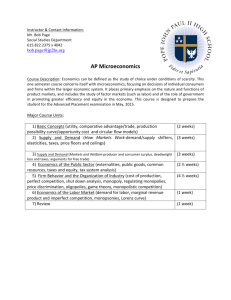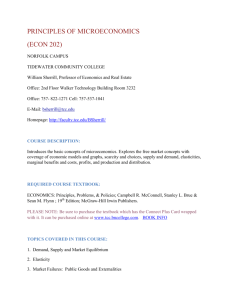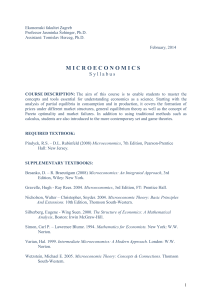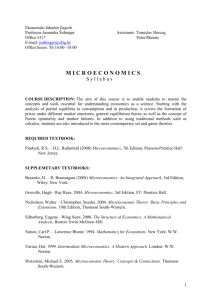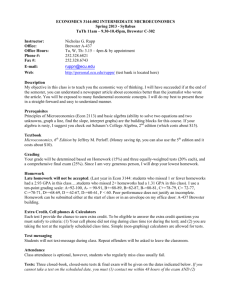Principles of Microeconomics ST. PETERSBURG COLLEGE
advertisement
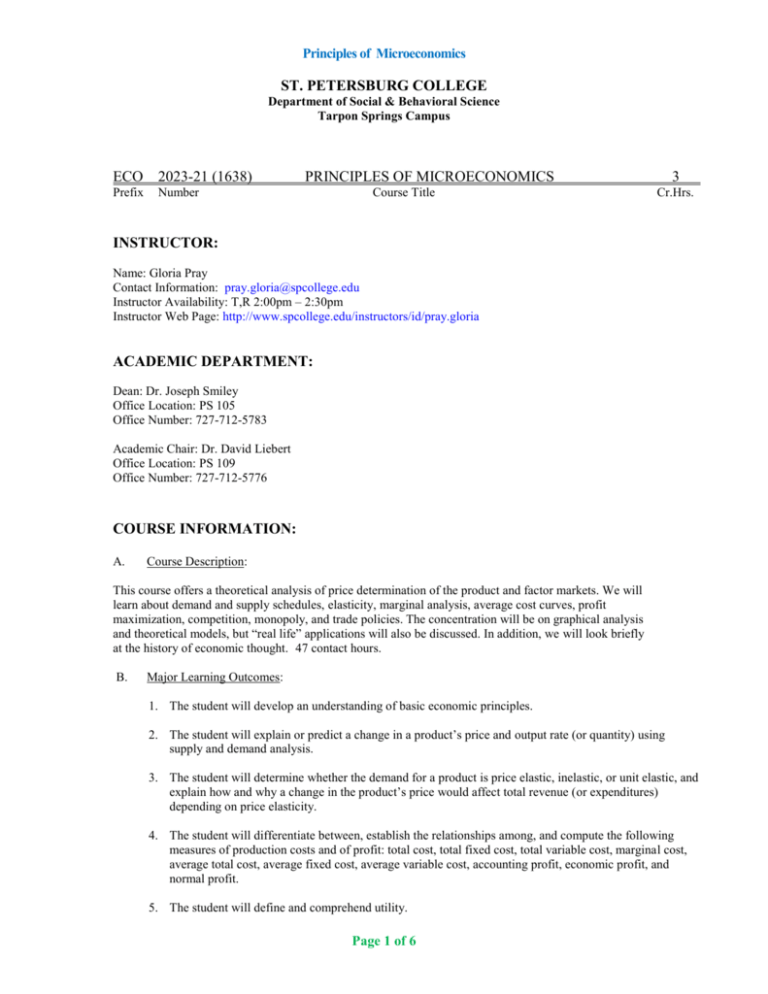
Principles of Microeconomics ST. PETERSBURG COLLEGE Department of Social & Behavioral Science Tarpon Springs Campus ECO 2023-21 (1638) Prefix PRINCIPLES OF MICROECONOMICS Number Course Title 3 Cr.Hrs. INSTRUCTOR: Name: Gloria Pray Contact Information: pray.gloria@spcollege.edu Instructor Availability: T,R 2:00pm – 2:30pm Instructor Web Page: http://www.spcollege.edu/instructors/id/pray.gloria ACADEMIC DEPARTMENT: Dean: Dr. Joseph Smiley Office Location: PS 105 Office Number: 727-712-5783 Academic Chair: Dr. David Liebert Office Location: PS 109 Office Number: 727-712-5776 COURSE INFORMATION: A. Course Description: This course offers a theoretical analysis of price determination of the product and factor markets. We will learn about demand and supply schedules, elasticity, marginal analysis, average cost curves, profit maximization, competition, monopoly, and trade policies. The concentration will be on graphical analysis and theoretical models, but “real life” applications will also be discussed. In addition, we will look briefly at the history of economic thought. 47 contact hours. B. Major Learning Outcomes: 1. The student will develop an understanding of basic economic principles. 2. The student will explain or predict a change in a product’s price and output rate (or quantity) using supply and demand analysis. 3. The student will determine whether the demand for a product is price elastic, inelastic, or unit elastic, and explain how and why a change in the product’s price would affect total revenue (or expenditures) depending on price elasticity. 4. The student will differentiate between, establish the relationships among, and compute the following measures of production costs and of profit: total cost, total fixed cost, total variable cost, marginal cost, average total cost, average fixed cost, average variable cost, accounting profit, economic profit, and normal profit. 5. The student will define and comprehend utility. Page 1 of 6 Principles of Microeconomics 6. The student will define and use the concept of competition. 7. The student will determine a firm’s profit-maximizing price, output rate, and profit, and explain whether, how, and why it should change its price or output rate to maximize its profit in any of the four basic market structures (pure competition, monopolistic competition, oligopoly, or monopoly) using the profitmaximization rule. 8. The student will comprehend deregulation and its effects. 9. The student will comprehend the structure of the labor market and develop and graph the demand for labor curve. 10. The student will define the impact of taxes on business structures. 11. The student will demonstrate knowledge of international trade (comparative advantage) and its benefits to the economy. 12. The student will show an understanding of the problems faced by developing countries. C. Course Objectives Stated in Performance Terms: 1. The student will demonstrate knowledge of the basic tools needed to understand current economic theory by: 2. a. defining economic terminology. b. identifying and recalling mathematical formulas used to solve problems involving basic economic principles. c. identifying, illustrating and interpreting graphs. d. recalling basic math and algebra. The student will explain or predict a change in a product’s price and output rate (or quantity) using supply and demand analysis by: a. illustrating these principles graphically. b. identifying and explaining the principles of equilibrium. c. identifying and explaining the principles of D & S shifts. 3. The student will determine whether the demand for a product is price elastic, inelastic, or unit elastic, and explain how and why a change in the product’s price would affect total revenue (or expenditures) depending on price elasticity by: 4. a. identifying, illustrating and interpreting graphs and charts. b. using basic math and algebra to work with elasticity formulas. c. using basic math to find revenue. The student will differentiate between, establish the relationships among, and compute the following measures of production costs and of profit: total cost, total fixed cost, total variable cost, marginal cost, average total cost, average fixed cost, average variable cost, accounting profit, economic profit, and normal profit by: Page 2 of 6 Principles of Microeconomics 5. a. identifying, illustrating and interpreting graphs and charts. b. using basic math and algebra to work with cost functions and profit formulas. The student will define and comprehend utility by: a. interpreting graphs and charts. b. using basic math and algebra to work with utility functions and consumer equilibrium theory. 6. The student will define and use the concept of competition as it applies to perfect competition and monopolistic competition. 7. The student will determine a firm’s profit-maximizing price, output rate, and profit, and explain whether, how, and why it should change its price or output rate to maximize its profit in any of the four basic market structures (pure competition, monopolistic competition, oligopoly, or monopoly) using the profitmaximization rule which includes: a. using graphs and charts to find profits. b. using basic math and algebra to find profits. 8. The student will comprehend deregulation and antitrust policies on just monopolies. 9. The student will comprehend the structure of the labor market and develop and graph the demand for labor curve using a basic math formula. 10. The student will define the impact of taxes on business structures. 11. The student will demonstrate knowledge of international trade (comparative advantage) and its benefits to the economy by: 12. a. identifying the basic reasons for specialization and trade. b. explaining the relationship between foreign exchange and international trade. The student will show an understanding of the problems faced by developing countries by comparison of demographics and other statistics to that of developed countries. REQUIRED TEXTBOOK & OTHER RESOURCE INFORMATION: The Economy Today, Bradley R. Schiller, 13th edition ISBN: 978-0-07-352321-7 Recommended Reading: Economics in One Lesson, Henry Hazlitt; Capitalism and Freedom, Milton Friedman Library: http://www.spcollege.edu/central/libonline/ TUTORING: TBA MEETING INFORMATION: Course Location: PS 138 Meeting Days: M / W, 08/17/15 – 12/09/15 Class Times: 11:00am – 12:15pm Page 3 of 6 Principles of Microeconomics IMPORTANT DATES: Non-Class Dates: 9/07/2015, 10/20/2015, 11/11/2015, 11/25-29/2015 Dates to Withdraw with a Refund: 08/21/2015 Withdrawal Date Academic: 10/22/2015 Financial Aid: http://www.spcollege.edu/central/SSFA/HomePage/calendar.htm DISCIPLINE SPECIFIC INFORMATION: Discussion, lecture, board work, and handouts are used to present material. Students must be able to explain, graphically illustrate, numerically calculate and recognize all material presented in class or the textbook that applies to course objectives. This is a math intensive course. ATTENDANCE: The college-wide attendance policy is included in the Syllabus Addendum at http://www.spcollege.edu/webcentral/policies.htm. 10% of your final grade will be based on attendance and participation. This is designed to reward you for coming to class, on time, and making an effort. Being absent, tardy, or leaving early will take points away from that grade. Everyone starts with 100%. How much it helps you depends on your individual average. At the end of the semester, both your average with and without attendance will be calculated and you will be given the higher average. If you will be absent for an exam, it is your responsibility to let me know ahead of time so that you can take it early. If you have a documented medical excuse, then e-mail me ASAP to make arrangements to take it before you return to class. Otherwise, you will take a make-up exam which will be considerably more difficult than a regular exam. You are expected to take all three exams. A student can voluntarily withdraw from this class up to 10/22/2015. If a student has violated the Active Participation policy for this class prior to that date, he or she will be given a grade of W/F unless the student voluntarily withdraws. The Active Participation policy is defined as missing more than 40% of scheduled classes (or 8 classes up to that date). Following this date, should a student be determined to no longer be actively participating (an additional 4 classes missed for a total of 12 for the semester), he or she will be given a grade of F at the end of the semester. GRADING: You will take three exams that will count toward 60% of your final grade (20% each). Both writing assignments (see assignments below) will account for 30% of your final grade (15% each). Finally, attendance and participation will account for 10% of your final grade. The scale is as follows: A = 85 – 100 B = 75 –84 C = 60 –74 D = 50 – 59 F = 49 and below Page 4 of 6 Principles of Microeconomics ASSIGNMENTS: You will be given two writing assignments over the course of the semester in which you will watch a video and write 1000 words for each. They will be graded on your understanding of the topic as well as grammatically. I am happy to preview your reports for content if you give me at least a few days. I also give extra credit to the grammar portion of the report for using the Writing Center. All exam reviews are due the class before the exam (I can preview that for you as well). All chapter outlines, exam reviews, and writing assignments (with web link) will be uploaded in MyCourses. COURSE OUTLINE: Chapter 1: Chapters 3;19: Chapter 20: Chapter 19: Chapter 21: The Core Issues: The PPC & Opportunity Costs Demand and Supply, Determinants Price Elasticity: Responsiveness of Demand Utility Theory The Costs of Production: Marginal Costs and Cost Curves (Short Run) EXAM 1 Chapter Chapter Chapter Chapter Chapter 21: 22: 23: 24: 27: The Costs of Production: Economies of Scale, Cost Curves (Long Run), Perfect Competition Competitive Markets (Short & Long Run) Monopoly Regulation of Business: Antitrust & Natural Monopoly EXAM 2 Chapter 25: Chapter 26: Chapter 30: Chapter 32: Chapter 35: Chapters 35;36: Chapters 36;37;2: Oligopoly Monopolistic Competition The Labor Market Uncertainty, Risk, and Financial Markets International Trade & Comparative Advantage Tariffs, Quotas & Exchange Rates The Microeconomics of Developing Countries EXAM 3 (Final) CLASS CONDUCT, INSTRUCTOR’S EXPECTATIONS AND EFFORTS: You are expected to conduct yourself in a mature and courteous manner. Smoking, eating, and drinking are not permitted in the classroom! Please turn off cell phones and beepers. It is intellectually impossible to hold a telephone conversation (including texting) and be actively participating in the class at the same time. In addition, I ask if you plan on bringing a laptop into the classroom you are using it for reasons immediately relevant to the conversation at hand and not surfing the internet, playing a video game, etc. I ask you to disconnect yourself from your radio, CD player, i-Pod, etc. at the start of class. If I see such disrespect towards the classroom community occurring, I will simply ask you to quietly leave for the remainder of the class with the expectation we will talk privately prior to our next class meeting. When communicating online, remember that information is saved and stored and can be referenced. Page 5 of 6 Principles of Microeconomics I strive to ensure the classroom affords a safe environment where every student feels he or she may share their ideas or voice their opinions. By the nature of many of the topics we address over the course of the semester, controversy may arise. I welcome the discussion and academic exploration of inherently sensitive and controversial issues in this classroom. I insist, however, students demonstrate personal respect for all others in the classroom and state sensitive subject matter in a way that reflects maturity and respect to other students on topics such as race, culture, gender, or sexual orientation. I understand obtaining a college education represents a serious challenge for many students that goes beyond the rigors of the curriculum. I respect the personal sacrifices students make in choosing to take on the challenges of a college education. Thus, you can expect I will ensure our classroom discussions will be relevant to the course objectives and class time will be set aside for review questions. I’ll make every effort to be available to speak with you after class as well as during my office hours. I can assure you that all assignments will be graded fairly, consistently, and returned promptly (typically next class for tests and one week for essays). I will start and end class on time and I ask my students to make every effort to be in class on time as late arrivals are very distracting to the class lectures. I expect all students to contribute to our classroom community by having the courage to ask questions and to share critical opinions and thoughts you might have on an assigned topic. If you don’t learn to speak up and/or ask for help in college, there is a good chance you never will. STUDENT SURVEY OF INSTRUCTION: The student survey of instruction is administered in courses each semester. It is designed to improve the quality of instruction at St. Petersburg College. All student responses are confidential and anonymous and will be used solely for the purpose of performance improvement. The SSI is completed through the course Angel page and found under the “Lessons” tab. Your instructor will remind the class at that point in the semester when the SSI is open and ready to complete. SIGNATURE PAGE: I have read, understand, and agree to abide fully by the parameters set in this syllabus and Syllabus Addendum. Student Signature: Date: Printed Name: Nickname (if different): Cell # (optional): Page 6 of 6
